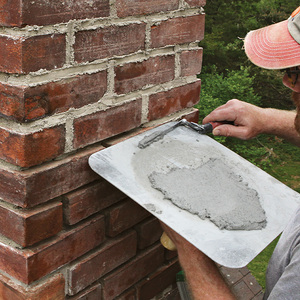GOOD AFTERNOON AND HAPPY NEW YEAR FROM FANCY GAP, VIRGINIA!
I’ve read FH for almost 2 decades, but only recently have moved fully into the 21st Century and gotten on line. From what I’ve seen so far, I seem to be in very good company. My question today concerns damp-proofing the crawl space under a manufactured home w/ brick underpinning. What is the current wisdom on acheiving a dry and odor-free environment in what I consider to be the 2nd closest place to hell-on-earth? Thanks in advance for your suggestions.




















Replies
I don't have any wisdom on this subject. I'm sure others will come along with practical advise and experience. But my first thought is ventilation. How is the space vented, and what options are there for improving ventilation?
--------
Oops - almost forgot my manners. Edited to add: Hello and welcome to Breaktime!
Edited 1/1/2006 1:20 pm by Huck
Where are you located? While Huck's often got some good wisdom to offer, if he's about to suggest increasing the ventilation, I'm going to disagree. Unless you live in the desert, ventilating a crawlspace may be more likely to wet it than to dry it.
Andy
Never try to teach a pig to sing. It wastes your time and annoys the pig.
Well, I'd hate to get drawn into a debate about increasing crawlspace ventilation or not, on a crawlspace I know almost nothing about. As I said, I'm not offering any "wisdom". My question was, Is the crawlspace vented? While I don't think I was out-of-line for suggesting a correlation between crawlspace moisture and ventilation, I acknowledge there is some controversy over the conventional wisdom of crawlspace ventilation. (And yes, I do live in the desert - most of So. Cal. is essentially a desert climate).
Clark Public Utilities, a utility service providing electric, water and wastewater service in Clark County, Washington (not in the desert!), had an interesting write-up on this subject on their website, clarkpublicutilities.com.
quoted in part, it said: "ventilation will help reduce moisture, and reducing ventilation will slow heat loss. Homeowners have to weigh advice they receive, and prepare for the consequences of following recommendations.
Your repairperson wanted to be sure the structural integrity of the home was not jeopardized by anything that could trap moisture under the house. He felt that it was important to keep a good airflow under the house, and the benefit of that airflow outweighed any potential energy savings or freeze protection that might be gained by closing the vents.
From a conservation and freeze-protection standpoint, we suggested closing crawlspace vents in Energy Adviser #103 “Winterize faucets, pipes in your home.” However, if there is standing water under the house or pre-existing mold colonies, these problems should be addressed before closing the vents. Also, vents should not be closed if there is no moisture barrier on the soil — the barrier is usually a continuous cover of heavy black plastic sheeting.
Early manufactured homes were often installed on simple concrete piers beneath their steel frames. There was no foundation around the perimeter of these homes, and set-up crews often installed metal skirting to close the gap between the floor of the home and the ground below. The skirting was usually vented to allow moisture to escape in the form of water vapor, and the soil below the house was graded to prevent standing water from collecting. Your repairman may have had a bad experience with an unvented skirting situation — when enough water collects under and around the concrete piers, they can tilt or even sink into the wet earth. Since the piers are the only devices keeping the home level, sunken or tilted piers mean a tipped house. This problem is a lot less likely when the home has an actual foundation, but your repairperson chose to advise caution.
In a site-built home with a typical foundation, it should be OK to close off the vents in the winter to protect the pipes. The energy savings of closed vents is less when the home has a well-insulated floor because the insulation helps protect the floor from heat loss. If the building has no floor insulation — and you can't afford to insulate it properly — closing off the vents might gain a noticeable savings and improve comfort.
In many parts of the country, homes are built with perimeter insulation — the walls of the crawlspace are insulated instead of or in addition to the floor. These types of homes are usually built without vents in the crawlspace, and extra care goes into the construction to assure the crawlspace floor is well drained and stays dry year-round.
Before you undertake any insulation or other energy-management project, thoroughly research options, prices and potential conflicts with other systems in your home. Visit with insulation contractors...
some more interesting info. is found at this website, which covers the debunking of the crawlspace ventilation myths. Essentially, both sides seem to agree that the issue needs to be decided on an individual basis, no blanket solution will cover all cases. In other words, more info. is needed. My intent was to get the conversation started by seeking some more specific information. Sorry if I misled anyone into thinking that crawlspace ventilation was the be-all do-all of moisture problem solutions. Only wanted to draw attention to it as a factor.
edited to add: BTW, the original poster gave his location, "FANCY GAP, VIRGINIA"
Edited 1/1/2006 8:01 pm by Huck
Climate is everything. You live in one place where ventilation probably does dry crawlspaces. I'd venture that's not true of anyplace east of the 100th meridian.Andy
Never try to teach a pig to sing. It wastes your time and annoys the pig.
OK, I'm here to be educated. The original poster's climate can be found here, (scroll down to about mid-page). So what do you recommend for keeping his crawlspace dry?
Close it, add a vapor barrier, and dehumidify. Outside air east of about the 100th meridian is often damp enough to condense in a cool crawlspace, so trying to dry one by ventilating with outside air is largely self defeating.Andy
Never try to teach a pig to sing. It wastes your time and annoys the pig.
Darn, Andy did you not read the first line in his post? (:-)
But he still should fill out his profile.
Edited 1/1/2006 10:19 pm ET by rasconc
Seen articles and like the idea of essentially a closed and conditioned crawl space. Think my dream house will have that.
Let's not confuse the issue with facts!
Conditioned by the same equipment used to condition the house, or is a separate heater/air conditioner recommended for the crawl space? Dehumidifier also? Perimeter insulated? Crawlspace floor - insulated, or just moisture barrier? And what type moisture barrier? Sounds like an expensive retrofit, but maybe not so bad if designed that way from the get-go.Most new housing here is slab-on-grade, but a lot of older homes have crawl spaces. Moisture is generally not a problem here (unless its related to plumbing problems), but termite infestation is.